
© Railway Wonders of the World 2012-


Cruising by Train
Novel Holiday Fashions have been Introduced by the Railways
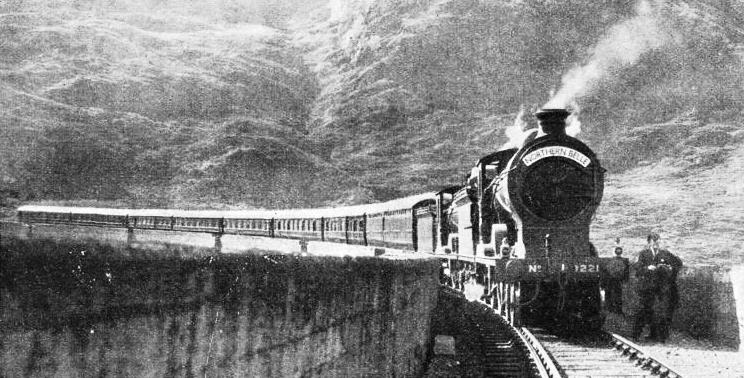
IN THE HIGHLANDS. On the journey between Mallaig and Fort William, Inverness. The cruising train stops on the Glenfinnan Viaduct, to enable passengers to enjoy the view down Loch Shiel and up the glen.
LUXURY train cruising and camping-
The idea of a land cruise was introduced by the London and North Eastern Railway in 1933, with the cruising train “Northern Belle”. The project was an adaptation of the fashion of liner cruising, and the first cruise was in the nature of an experiment; it met with such success that three cruises were made instead of one, and in 1934 and afterwards the number of tours made by the “Northern Belle” was increased to four. June was established as the cruising month.
The “Northern Belle” steams out of King’s Cross Station at 9 pm on Friday on its tour of 2,000 miles, and returns at 10.45 am the following Friday. The fare is £20, and sixty passengers are carried. The train is composed of fifteen first-
2-
It is claimed that the “Northern Belle” is the most unusual luxury train in Europe. The staff of the train numbers twenty-
The “Northern Belle” is as self-
Electrically heated water for washing and shaving is available in each cabin, and shower baths are provided. These baths are built up on three sides with green marble, and supply hot, cold or mixed showers, the water being obtained from tanks containing seventy-
There is a van equipped with wardrobe accommodation, providing space for each passenger; and hooks on which coats or mackintoshes may be dried, a provision which recommends itself to those acquainted with the Highlands.
There is a lounge saloon and writing-
We board the “Northern Belle” one Friday evening in June for a week of comfort and touring without worry. Everything has been arranged to the last detail. At 9 pm the train pulls out of King’s Cross Station for Barnard Castle, in Teesdale. It is due there at 3.05 am and will stop for the rest of the night.
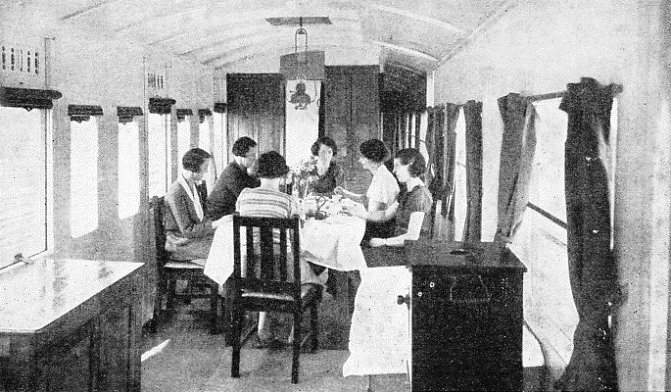
A CAMPING COACH. Another recent form of holiday-
Waking up on Saturday morning, we bathe and breakfast. At 9.30 am the train starts for Clifton Moor, arriving at 11.20 am. Five minutes later we are in motor coaches and travel through glorious Lakeland scenery, via Greystoke, Troutbeck and Threlkeld to Keswick, for lunch. Lunch over, we continue our coach tour. We see lovely Thirlmere, and go on to Grasmere, Rydal Water, Ambleside and Windermere. After tea we go over the Kirkstone Pass to Patterdale, passing along the shore of Ullswater to Pooley Bridge and Dalemain Park and on to Penrith Station, where the “Northern Belle” is waiting for us. The train leaves for Montrose at 7.15 pm, and we dine on the way. We arrive at Montrose at 1.18 am on Sunday. The train stands all night on the Inverbervie branch line, afterwards proceeding to Aberdeen, arriving at 8.08 am.
We can breakfast either on the train or at an hotel. At 11 the train leaves for Grantown-
Monday is a road day. We are taken to Braemar via Balmoral and Crathie and to Linn o’Dee, starting out at 10.30 am and returning to Ballater Station at 5.30 pm. On the way to Aberdeen we dine, and then make a coach tour of the city and its environs. We return to the train, which leaves Aberdeen at 11 pm, arriving at Dalmeny at 2.09 am. Here the train waits till morning, when it goes on to Balloch Pier for Loch Lomond.
Beautiful Britain
On Tuesday we go afloat. The “Northern Belle” arrives at Balloch Pier at 9.07 am, and we go aboard the Loch Lomond steamer for breakfast. The steamer takes us to Ardlui Pier, and we join the train again and lunch on the way to Fort William. The views from the train on the journey between Fort William and Mallaig are unsurpassable. The train stops at Mallaig to enable us to see this fishing port and enjoy the view of the Isle of Skye. We leave at 4.55 pm and at 6 pm the train stops on Glenfinnan Viaduct, so that we can appreciate the magnificent view down Loch Shiel and up the glen. We reach Fort William at 6.41 pm and dine on the train, which remains overnight.
Wednesday is devoted to further loch cruising. The train leaves Fort William at 9.18 am for Loch Long and Loch Goil, reaching Arrochar and Tarbet three minutes before noon. We embark in the steamer at Arrochar Pier and spend the afternoon cruising, disembarking at Craigendoran Pier at 4.25 pm. Thirteen minutes later the “Northern Belle” starts for Edinburgh, reaching the capital of Scotland at 6.05 pm, enabling us to dine at an hotel. At 11.15 pm we leave Waverley Station for Corstorphine, where the train stops all night.
We spend Thursday coach-
The “Northern Belle” leaves Edinburgh at five minutes after midnight, and at 10.45 am on Friday the cruise ends at King’s Cross Station, London.
Every night while the passengers are asleep the restaurant and saloon coaches are disconnected; in the morning the sleeping-
It is almost a social event to make this tour. Owing to the demands on first-
The tourist is to be envied, and passengers with slender purses have asked the railway company to arrange a tour to suit their pockets. A party of 200 Boy Scouts arranged a cruise on a third-
Just as the “Northern Belle”, catering for the holiday-
The luxurious “Northern Belle” and the modest camp-
The idea was suggested by Mr. C. J. Cutcliffe Hyne, the author. After it was put into operation in 1933 by the London and North Eastern Railway, the Great Western Railway and the London Midland and Scottish Railway followed in 1934, and the Southern Railway later. In the short space of two years the ten coaches converted into homes on wheels had grown to more than two hundred. In that short time the number of campers had grown to thousands.
The coaches are called camping coaches, camp-
A Home on Wheels
The principle behind the “Northern Belle” and the modest camp-
Dealing first with the fixed camp-
This kind of holiday removes the discomfort from the more orthodox camping under canvas. When the novelty of sleeping under canvas wears off, some campers notice the discomforts. There is no such snag about the camp-
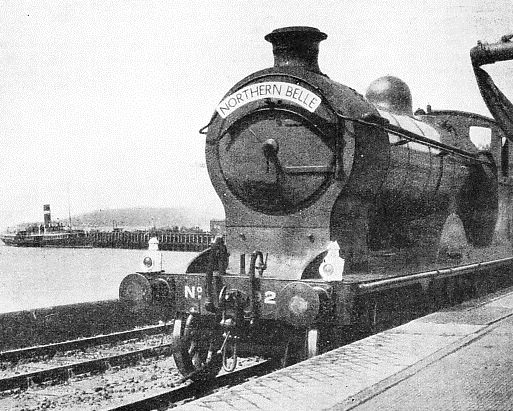
THE “NORTHERN BELLE”, at Craigendoran Pier. Passengers spend several hours cruising by steamer on Loch Long and Loch Goil before they rejoin the train.
Scattered over the country are hundreds of little places which retain the spirit of peace. There are wayside stations on branch lines which were busy in Victorian times, but are now quiet; perhaps only two or three trains pass a day. It is at these spots that camp-
There is no trouble about camping sites or rents, or with horses and cattle disturbing the camp in the very early morning when campers are asleep. Steps are hitched on to the sides of the coach to facilitate entering and leaving “home”.
The camp-
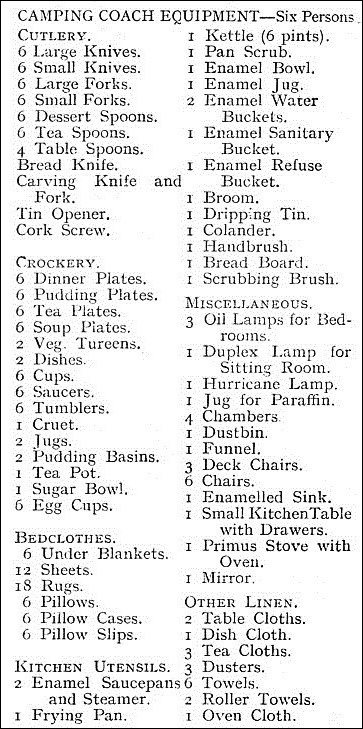
Residence for the week is always taken up from one Saturday afternoon to the following Saturday morning.
Each company has a list of sites from which the camper can choose. One can camp at Princetown, almost in the heart of Dartmoor, at 1,373 ft above sea level, or on the Roman Wall, on the Lincolnshire coast, in rural Essex, in the North of Scotland, the Lake District, Wales or Southern England, and thus enjoy every variety of scenery in the country.
Sites for Camping
There are sites in the New Forest at Hum (near Christchurch), in East Devon, North Cornwall and North Devon. Blue Anchor, on a sandy beach about four miles east of Minehead, is near the ancient Cleeve Abbey. Lustleigh is a village in a lovely valley on the outer fringe of Dartmoor. Haytor Rocks, Rippon Tor, Widecombe-
There are three sites -
For those who wish to explore Wales there are sites at Dinas Mawddwy, Llanfyllin and Rhayader. Dinas Mawddwy, the terminus of a branch line from Cemmes Road, is a village ringed by a wall of mountains. Llanfyllin is the terminus of a branch line from Llanymynech.
If the campers desire it, the local station-
The touring camping coach which changes its site every night is more expensive. The London and North Eastern Railway charge from £15 to £20 a week for a coach which has six separate sleeping compartments and, in addition, accommodation for a seventh person in a spare compartment that is equipped with a collapsible bed.
This coach leaves York in the holiday season on Saturday afternoons, and visits Pateley Bridge, Aysgarth, Barnard Castle, Glaisdale and Coxwold. Every evening it is coupled on to a train and shifted, and during the week travels 276 miles. The occupants thus explore Nidderdale. Swaledale and the North Yorkshire moors. Each tour is booked for one party only, and the complement is not made up of different sets of people.
Each company has made it a rule that the members of the party hiring a camp-
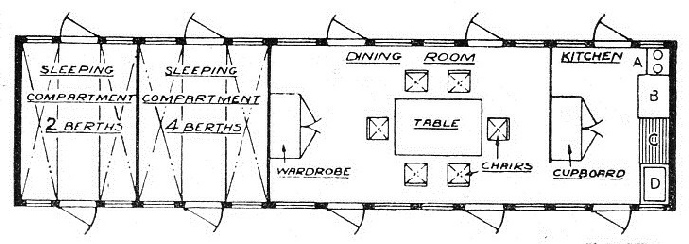
THE PLAN OF A CAMPING COACH. These coaches are usually designed to accommodate six people. A is a stove, with an oven; B, a table and cupboard; C, a draining board; and D, the sink.
To make the holiday a success it is suggested that each party elects a “jobmaster” to superintend arrangements, allocate the camp duties day by day, and to see that the coach is kept clean and tidy. The buying of food and the cooking should be the responsibility of one person.
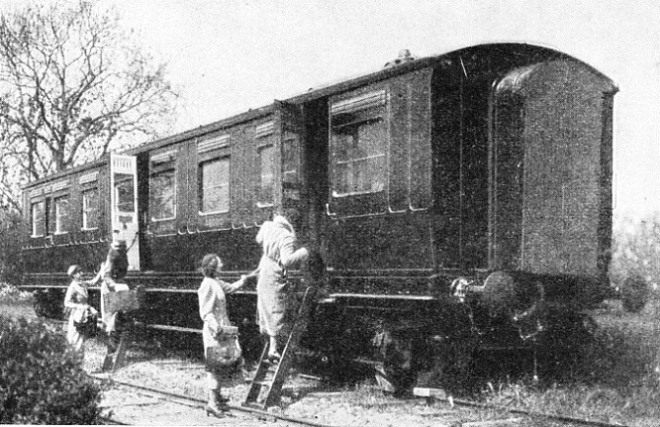
TAKING POSSESSION of a house on wheels. This picture shows the happy arrival of a party of holiday-
You can read more on “The Railways of Caledonia”, “Scottish Mountain Railways” and
“Seeing the Scenery” on this website.
The “Northern Belle” also featured on the covers of part 26 and part 41